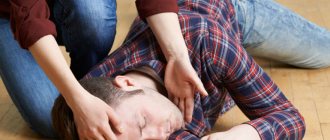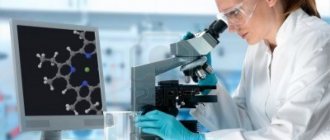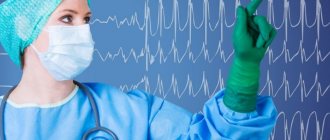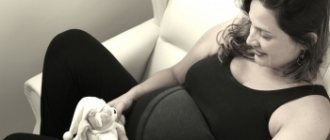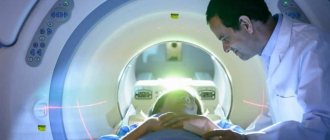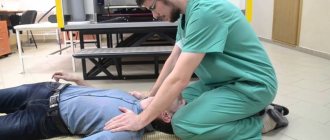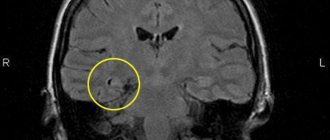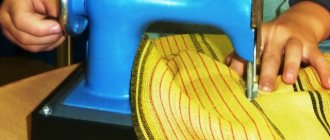Home>Articles>Alcoholic epilepsy
quick menu (hide)
- Reasons for appearance
- How does an attack go?
- Consequences and risks
- How is the treatment carried out?
- Treatment of alcoholism as a solution to the problem
Alcoholic epilepsy is a type of psychosis caused by prolonged consumption of alcohol in large doses. It usually appears at the 3rd stage of addiction. In the presence of external catalytic factors, it may appear earlier. At the initial stages, it does not have a pronounced form of seizures with tremor and paralysis, but rather manifests itself in irritability, absent-mindedness and other sudden changes in behavior. Without taking measures, it further develops to a state of pronounced epileptic seizures.
An alcoholic epilepsy attack occurs suddenly, so the disease is primarily dangerous for the person who drinks. However, manifestations of aggression and anger in the later stages are dangerous for others, since during a seizure, a person does not control his own behavior.
Reasons for appearance
The causes of alcoholic epilepsy, like most other pathologies in alcoholics, come down to organ disorders caused by the influence of alcohol. In this case, we are talking about damage to the brain. The fact is that long-term consumption of alcohol, especially with periodic heavy binges, leads to the accumulation of toxic substances and breakdown products of ethyl alcohol in the body. They affect all organs and lead to problems in the blood supply to the brain, which in turn causes irreversible and destructive consequences.
The problem is cumulative in nature, invisible in the initial stages, and becomes more and more noticeable after the 2nd stage of alcoholism. Therefore, most often, the disease manifests itself in alcoholics with a long history of addiction. However, in some cases, alcoholic epilepsy develops faster due to additional factors damage , for example, due to trauma, severe viral infections.
Alcohol and smoking
The ban on alcohol and smoking applies to any period of treatment . In the adult generation, the initial stage of the disease is provoked precisely by the abuse of alcohol and smoking. The most dangerous use of alcoholic beverages is when constantly taking barbiturates and medications with benzodiazepines due to the likelihood of developing accelerated and deep intoxication, failures in coordination and loss of consciousness. If treatment has helped a person, then the consumption of alcoholic beverages should be limited, but it is best to completely abstain from the harmful drink. At the appointment, doctors always recommend completely abstaining from alcohol, smoking, and especially the use of narcotic substances. Many experts believe that after the body has fully matured and strengthened (after about 27 years), limited alcohol consumption is allowed for epilepsy. The volume should not exceed a couple of standard drinks. During the day it is prohibited to consume more than 50 grams of strong alcohol (vodka, fortified wine) or a half-liter bottle of beer. If in the life of a patient with epilepsy there are other violations of the regime - a hard day with emotional stress, late sleep, then it is better to completely abstain from alcoholic beverages, even in certain doses.
How does an attack go?
Alcoholic epilepsy, the causes of which lie in disruption of the brain and other organs due to poisoning with the breakdown products of ethyl alcohol, is similar to standard epilepsy. The main and most striking difference is the disturbance of consciousness in alcoholics immediately before and after an attack. The disorder manifests itself in different ways. The patient may be in an unnaturally elevated or, on the contrary, depressed state, and exhibit excessive activity. In some cases, the appearance of auditory and sound hallucinations is observed.
Before, as well as during the seizure itself, a person behaves as follows:
- An attack can start with muscle pain, a compressive or acute headache;
- Due to contraction of the vocal cords, the patient experiences loud, uncontrollable screams;
- Uncontrolled urination occurs;
- Control of consciousness disappears, manifesting itself in different ways, from hallucinations to hysterics and aggression;
- A seizure is accompanied by muscle contractions resembling convulsions, tension in the limbs and other muscles of the body;
- The pulse increases noticeably - up to 170 beats per minute, while breathing, on the contrary, slows down due to tension in the lungs. The respiratory rate periodically decreases to 8 exhalations per minute;
- There is arching of the body due to muscle contraction; depending on the area of brain damage, the attack is accompanied by distortion of facial features or spasms of the limbs, or a combination of all symptoms in the most severe cases.
Recovery from an attack occurs quite suddenly. However, after suffering stress, the patient continues to feel pain in the limbs and other muscles, causing temporary paralysis. The pain continues for some time, after which the condition gradually clears up.
Alcoholic epilepsy, the consequences of which can be sad, is one of the manifestations of psychoses caused by alcoholism. Seizures rarely occur during heavy drinking. As a rule, they occur on the second or third day after, especially with a sharp exit from binge drinking. In some cases, there may be precursors of an attack, manifested in the form of headaches, dry mouth and other manifestations of malaise caused by poisoning.
Alcoholic epilepsy
Alcohol abuse leads to many destructive consequences in the body. Everyone knows the harmful effects of ethyl alcohol on the liver, heart, kidneys, and blood vessels. However, the brain, as one of the main consumers of blood, is very sensitive to this kind of toxin, and when receiving a hefty dose of poison, it is destroyed. The cells become sick and die, respectively, the affected areas do not function correctly, against the background of which alcoholic epilepsy develops, which can manifest itself both during alcohol consumption and during withdrawal upon withdrawal.
Risk factors
- Long drinking bouts.
- Poor quality drinks containing methanol.
- Traumatic brain injuries.
- Genetic predisposition.
- Circulatory dysfunctions, tumor neoplasms.
- Substances containing ethanol and not intended for ingestion.
It is customary to distinguish between single epileptic seizures caused by a hangover, as well as a chronic form, in people who are at risk, often go on binge drinking, and consume counterfeit, moonshine and other unlicensed liquids.
Consequences and risks
The consequences of seizures are the most dire, especially if the alcoholic is often left alone. Convulsions are accompanied by loss of coordination and loss of consciousness. In this condition, the patient is capable of injuring himself by falling or further in spasmodic attack. In addition, severe pain and disturbances in the functioning of the heart can provoke many negative consequences, causing a stroke or other problems.
If you do not take action and do not treat both epilepsy itself and alcoholism, which creates a negative background for many other problems, the situation will end in death or irreversible brain damage. If you notice the first symptoms of a seizure or a tendency to have one, you should immediately seek help from specialists.
Symptoms
The first signs of seizure disorders can occur at any stage of addiction, but more often closer to the 2nd-3rd.
The average age of such patients is 30-45 years. But still, the time of appearance and the very presence of epileptic seizures is determined by specific clinical cases and individual characteristics of a person. There is no uniform understanding of the clinical picture of epileptiform disorders. I.N. Pyatnitskaya considers seizures only as part of the withdrawal syndrome. Foreign narcologists believe that it is also necessary to take into account convulsive attacks that occur during the period of direct intoxication or delirium (severe psychosis).
Personality changes of the epileptic type, which occur in other types of epilepsy, are not typical for alcoholic epilepsy, however, the existing personality degradation is aggravated - the sick person becomes embittered, picky, loses moral and ethical qualities, attention and memory decrease. The frequency of seizures usually does not exceed 1-3 times a year. The presence of convulsive attacks in alcoholics indicates the presence of alcoholic encephalopathy in 100% of cases, while changes in the brain are irreversible. The peculiarities of alcoholic epilepsy include the fact that in the first years of the disease, in the period between convulsive seizures, there may be no epileptic signs on the EEG.
Donskoy V.V., Sukhanova N.S., Gusev A.M., Kolontai M.V. Convulsive syndrome in alcoholism // Omsk Psychiatric Journal. 2014. No. 2 (2).
Before the attack
During an epileptic seizure, the normal functioning of gray matter cells (cerebral cortex) is temporarily disrupted due to pathologically uncontrolled electrical activity. A developing acute episode can be suspected based on the following signs:
- mood swings;
- anxiety;
- fear;
- negative attitude;
- fatigue;
- psychomotor agitation with delirium;
- tendency to aggression;
- fear;
- decreased performance;
- auras – the appearance of unusual sensations from the senses: strange smells, visual and auditory illusions, incomprehensible sounds.
Precursors manifest themselves differently in patients. Symptoms become more pronounced several days or hours before the seizure occurs. There are no twilight disorders or personality changes characteristic of classical epilepsy; the direct connection with the intoxication factor is important.
Epileptiform seizure clinic
Binges are characterized by the formation of “large” convulsive seizures without an aura and warning signs. An attack of alcoholic epilepsy may include the following symptoms:
- loss of consciousness - a person suddenly falls;
- a feeling of contraction or tightening of muscles;
- sharp clenching of the jaws;
- clonic and/or tonic convulsions – unnatural body posture, convulsions, spontaneous throwing back of the head;
- burning pain;
- involuntary urination;
- confusion;
- memory loss;
- disturbances in heart rate and breathing;
- mental symptoms: hallucinations, delusions, illusions, emotional disorders;
- during abstinence – typical manifestations of “o.
Symptoms often appear abruptly. Often convulsive episodes are repeated at short intervals over several hours.
An unfavorable outcome is considered to be transformation into epistatus - attacks follow in a row for more than 30 minutes, the person does not regain consciousness between them.
After the attack
After the convulsions subside, the person slowly regains consciousness or falls asleep for 1-3 hours. With a mild course, they appear and end suddenly. If epileptiform phenomena accompanied delirium, mental disorders may persist until the end of the post-intoxication period.
In the morning, victims discover injuries caused by convulsions. There is still a feeling of contraction of the muscles of the limbs or pain in them. Upon exiting the binge, the mood is sharply reduced, the sick are weak and apathetic. Signs of dysfunction of internal organs, provoked by prolonged alcoholism, come to the fore.
How is the treatment carried out?
Alcoholic epilepsy, the symptoms of which are a reaction to damage and malfunction of the brain, is a consequence of alcoholism. The occurrence of this type of psychosis is a sign that the body is working to the limit and in the near future, under the same loads, the saddest outcome will come if you do not radically change your life.
Treatment of epilepsy takes place in a hospital or at home, after calling a narcologist. Drug therapy is used for treatment In particular, the following types of drugs are used:
- Antispasmodic drugs;
- Drugs for restoring memory and brain activity;
- Sedatives and tranquilizers;
- Products for detoxification of the body;
- Vitamin cocktails to restore strength after a seizure.
Drugs are selected strictly on an individual basis, treatment occurs a course , with additional medications taken during an attack or when warning signs appear. The dosage and time of administration are also prescribed by the doctor; experimenting with them on your own is not recommended.
In combination with therapy prescribed by a specialist, it is allowed to use traditional medicine techniques, drink infusions and decoctions of herbs to calm and cleanse the body. Maintain rest and bed rest until full recovery.
Treatment
Before the doctor arrives, you can take the following actions. Sharp, piercing and cutting objects should be removed and furniture should be moved away if possible.
It is best to place soft blankets and pillows on the floor, and open the windows to ventilate the room.
Remove constricting items of clothing from the patient: tie, socks, insert a folded towel into the mouth. Try to keep the person on their side to prevent them from accidentally choking on vomit.
Do not leave the victim alone; stay with him until the ambulance arrives.
Relatives need to know that the psychiatric team must hospitalize an alcohol addict. He will be taken to the hospital, intensive care unit, or intensive care unit.
Emergency therapy consists of the following measures: tranquilizers, muscle relaxants and other drugs are administered as part of droppers. According to indications, the person is connected to a ventilator, and symptomatic treatment is provided for concomitant pathologies.
Neurologists, psychiatrists, and narcologists treat alcoholic epilepsy. The joint efforts of specialists make it possible to bring the patient out of a critical condition and normalize his well-being.
Treatment of alcoholism as a solution to the problem
Alcoholic epilepsy, the treatment and relief of which can be carried out relatively successfully both in the hospital and at home, is only a symptom of the underlying disease. The main cause of such diseases is alcohol addiction . To prevent attacks of epilepsy and other forms of psychosis from recurring again and again, you need to completely stop drinking or reduce alcohol consumption to a safe minimum.
To treat alcoholism, you need to seek professional help from a narcologist. The procedure includes both the medication part of the therapy and work with a psychologist, and often with a psychiatrist. The manifestation of epilepsy, delirium tremens and other psychoses is an extreme symptom of addiction, in which a person needs to be saved in the literal sense. To get started, you need to contact specialists who will provide assistance.
Consequences
- Physical damage. During an attack, a person falls and therefore risks injury. Vomiting clogs the airways and can cause suffocation.
- Mental. The patient loses his will and professional skills, becomes frivolous, shows no interest in life, and thinks primitively. Becomes scandalous and depressive. If left untreated, seizures can cause serious brain damage, impair a person's ability to think, and destroy a person's personality.
- Status epilepticus. This is a consequence of alcoholic epilepsy, in which seizures occur in series over several minutes. They can cause cardiac arrest, respiratory arrest, cerebral edema, and coma.
Third group
Clinical features:
- the patient abuses alcohol, he has convulsions, but convulsive conditions never occur against the background of a sharp cessation of alcohol consumption;
— in this case we are talking about primary alcoholic epilepsy and the secondary negative effect of alcohol, which aggravates the convulsive activity of the brain;
- alcoholism in patients with idiopathic epilepsy has a severe course and rapid development. The state of intoxication is characterized by agitation, aggression and memory loss;
- at the beginning of the disease there may be undeveloped (abortive) seizures. Over the years, as alcoholism becomes more severe, the severity of convulsive attacks increases, up to generalized ones with the transition to epistatus.
Diagnostics:
— convulsive brain activity can be diagnosed on an EEG while awake, during photostimulation or physical activity; in 100% of cases it is recorded on the EEG during sleep.
Treatment:
- continuous use of anticonvulsants is indicated;
- in case of ongoing alcoholism, anticonvulsant treatment may be ineffective.
What happens during an epileptic attack
The brain and spinal cord (central nervous system) are made up of many billions of cells, also called neurons. Neurons are organized into groups in the central nervous system. The different groups communicate with each other and with the rest of the body using electrical signals in nerve fibers. Signals from neurons through nerve fibers are responsible for vision, smell, hearing, thoughts, emotions and human movements.
Epileptic seizures occur when a group of cells begin to function abnormally. This is usually caused by a short circuit in the signals. The abnormal electrical signals will then be transmitted to other parts of the brain and body, depending on which neurons are activated.
For example, if only part of the brain is affected, the seizure may consist of arm retraction, smelling, or disorientation. If the entire brain is involved, loss of consciousness and seizures usually occur in all muscles of the body, with twitching in the arms and legs.
The electrical signals of epilepsy can be very intense. After this, the neurons need some time to recover from the heavy discharge. Therefore, a person experiences fatigue and confusion after an epileptic seizure.
